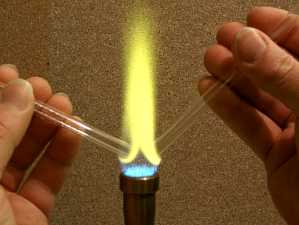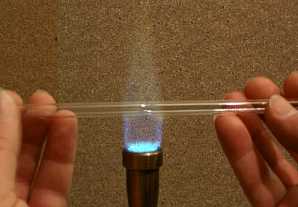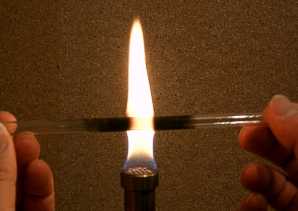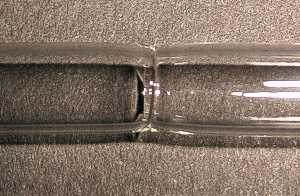
Glass Blowing for Vacuum Devices
Joining and Annealing
 I hold the tubes in a low flame at an angle so that the ends get the most heat. If the
top ends of the tubes are open, I keep my hands away from them. Gas can collect
and burn inside the tubes. As soon as the flame turns an orangy yellow, I gently press
the hot ends of the tubes together. The glass must not be too hot or the joint will
thicken badly. If it is not hot enough a gas tight joint will not be made.
I hold the tubes in a low flame at an angle so that the ends get the most heat. If the
top ends of the tubes are open, I keep my hands away from them. Gas can collect
and burn inside the tubes. As soon as the flame turns an orangy yellow, I gently press
the hot ends of the tubes together. The glass must not be too hot or the joint will
thicken badly. If it is not hot enough a gas tight joint will not be made.
 I then rotate the joint higher up in the flame so that it cools slightly and then gently
pull on the far ends of the tubes to straighten it up. I then immediately proceed with
the annealing.
I then rotate the joint higher up in the flame so that it cools slightly and then gently
pull on the far ends of the tubes to straighten it up. I then immediately proceed with
the annealing.
 When glass is joined and formed, stresses are introduced. This makes the glass likely to
crack if subjected to temperature changes or mechanical shock. Hand annealing spreads the
stresses around to make the glass more resilient.
When glass is joined and formed, stresses are introduced. This makes the glass likely to
crack if subjected to temperature changes or mechanical shock. Hand annealing spreads the
stresses around to make the glass more resilient.
The air inlet on the burner must be closed to produce a bright yellow sooty flame.
I rotate the tube in the flame while slowly moving it from side to side until the joint
and the areas either side of it become covered in black soot. I then wrap the tube in
ceramic wool and leave it to cool slowly.
 After wiping of the soot with a paper towel, it looks like this. There are ways
of tidying up the joint to make the wall thickness more even. This involves
blowing a small bulb on the joint and then drawing it back down to the same diameter
as the tube. In this way, the joint can be made almost invisible, but this requires a
great deal of skill, which I don't possess.
After wiping of the soot with a paper towel, it looks like this. There are ways
of tidying up the joint to make the wall thickness more even. This involves
blowing a small bulb on the joint and then drawing it back down to the same diameter
as the tube. In this way, the joint can be made almost invisible, but this requires a
great deal of skill, which I don't possess.
 I hold the tubes in a low flame at an angle so that the ends get the most heat. If the
top ends of the tubes are open, I keep my hands away from them. Gas can collect
and burn inside the tubes. As soon as the flame turns an orangy yellow, I gently press
the hot ends of the tubes together. The glass must not be too hot or the joint will
thicken badly. If it is not hot enough a gas tight joint will not be made.
I hold the tubes in a low flame at an angle so that the ends get the most heat. If the
top ends of the tubes are open, I keep my hands away from them. Gas can collect
and burn inside the tubes. As soon as the flame turns an orangy yellow, I gently press
the hot ends of the tubes together. The glass must not be too hot or the joint will
thicken badly. If it is not hot enough a gas tight joint will not be made.
 I then rotate the joint higher up in the flame so that it cools slightly and then gently
pull on the far ends of the tubes to straighten it up. I then immediately proceed with
the annealing.
I then rotate the joint higher up in the flame so that it cools slightly and then gently
pull on the far ends of the tubes to straighten it up. I then immediately proceed with
the annealing. When glass is joined and formed, stresses are introduced. This makes the glass likely to
crack if subjected to temperature changes or mechanical shock. Hand annealing spreads the
stresses around to make the glass more resilient.
When glass is joined and formed, stresses are introduced. This makes the glass likely to
crack if subjected to temperature changes or mechanical shock. Hand annealing spreads the
stresses around to make the glass more resilient. After wiping of the soot with a paper towel, it looks like this. There are ways
of tidying up the joint to make the wall thickness more even. This involves
blowing a small bulb on the joint and then drawing it back down to the same diameter
as the tube. In this way, the joint can be made almost invisible, but this requires a
great deal of skill, which I don't possess.
After wiping of the soot with a paper towel, it looks like this. There are ways
of tidying up the joint to make the wall thickness more even. This involves
blowing a small bulb on the joint and then drawing it back down to the same diameter
as the tube. In this way, the joint can be made almost invisible, but this requires a
great deal of skill, which I don't possess.